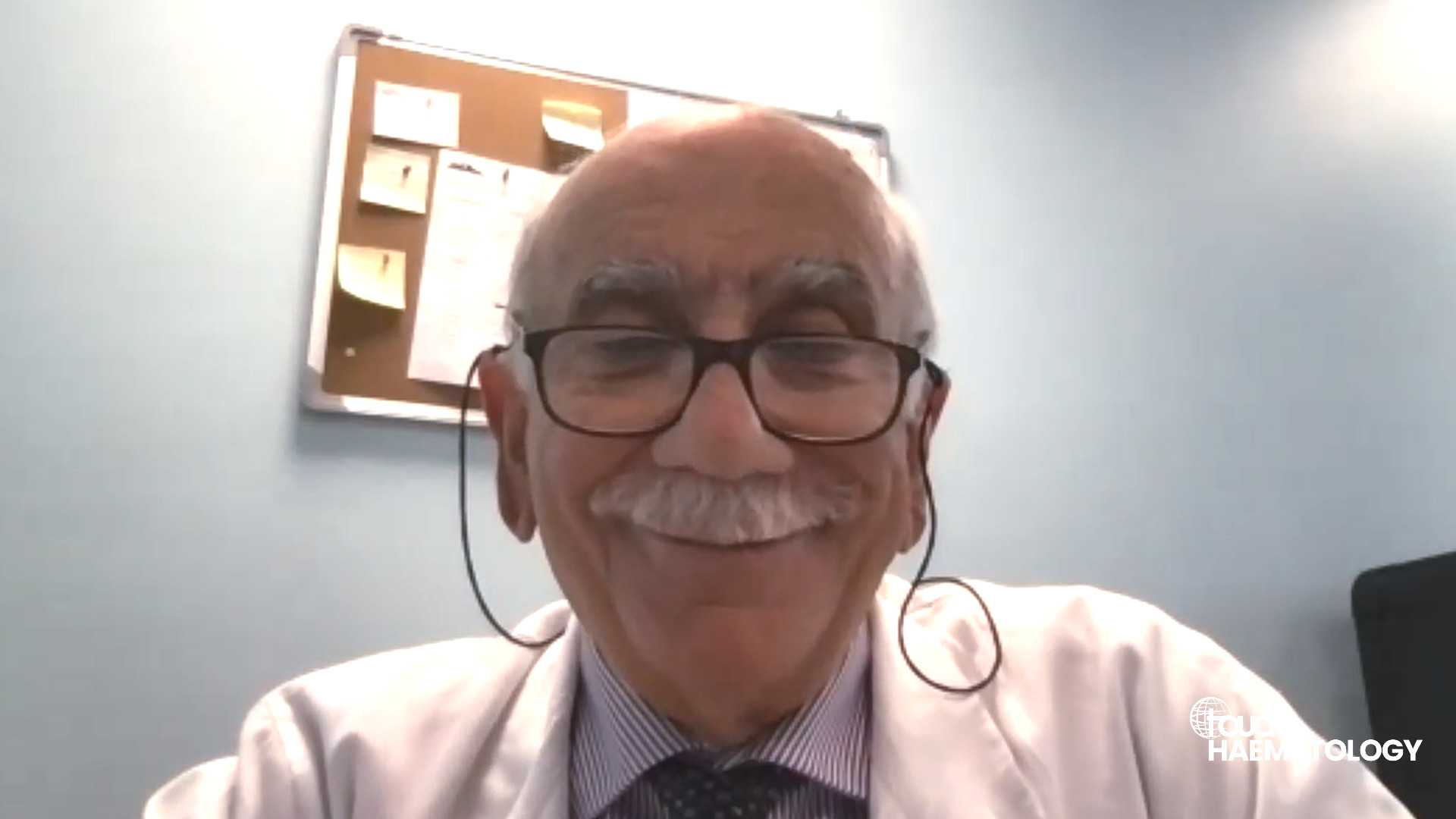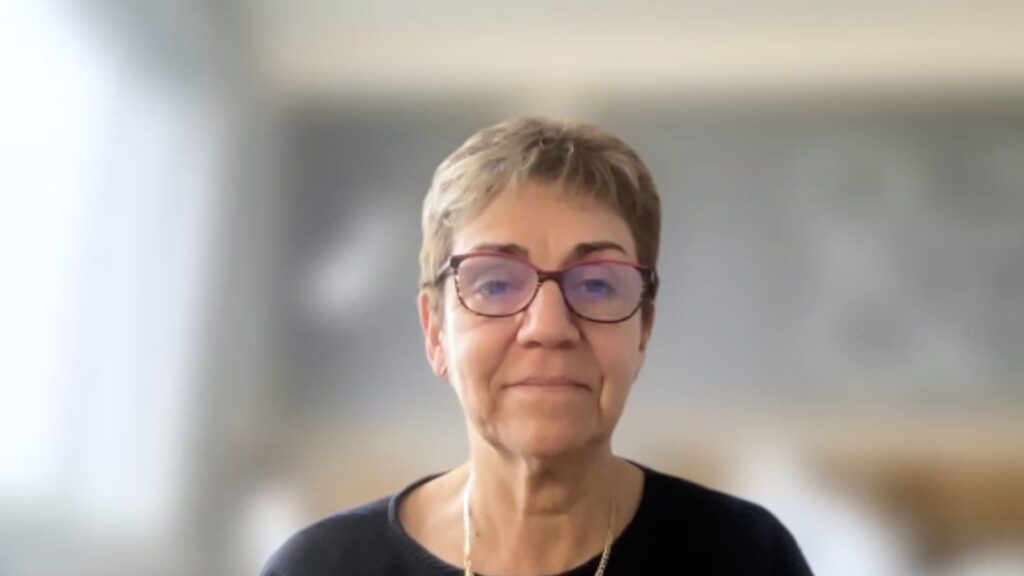touchHAEMATOLOGY coverage of data presented at EHA 2024:
The EORTC-1537-COBRA trial investigated the efficacy of very early FDG-PET/CT response-adapted therapy in patients with advanced-stage Hodgkin lymphoma using brentuximab vedotin-containing regimens, i.e. brentuximab vedotin, doxorubicin, vinblastine and dacarbazine (A-AVD); and brentuximab vedotin, etoposide, cyclophosphamide, doxorubicin, dacarbazine and dexamethasone (BrECADD). This phase II study enrolled 150 patients, all of whom received an initial cycle of A-AVD, followed by an early PET/CT scan. Patients with negative PET results (Deauville scores 1–3) continued with A-AVD, while those with positive results (scores 4–5) switched to BrECADD. Radiotherapy was given only to those with residual PET positivity after chemotherapy.
Prof. Martin Hutchings (Rigshospitalet, Copenhagen, Denmark; University of Copenhagen, Copenhagen, Denmark) joins touchHAEMATOLOGY to discuss the efficacy and safety data from the EORTC-1537-COBRA trial, presented at EHA 2024.
The abstract entitled “EORTC-1537-COBRA: Very Early FDG-PET-response Adapted Targeted Therapy For Advanced Hodgkin Lymphoma: A Single-Arm Phase II Study” (Abstract S226) was presented at the 29th European Hematology Association (EHA) 2024 Congress on 13–16th June 2024 in Madrid, Spain.
Questions:
- Please can you explain the rationale, primary objectives and design of the EORTC-1537-COBRA trial? (0:19)
- How does the addition of brentuximab vedotin to conventional chemotherapy regimens differ from previous treatment protocols for classical Hodgkin lymphoma (cHL)? (0:58)
- What were the main findings of the study in terms of modified progression-free survival (mPFS) and complete metabolic response? How do these results compare to historical data from the ECHELON-1 study? (2:24)
- Can you discuss the significance of the PET1-negative and PET1-positive patient outcomes observed in this study? (3:41)
- What do data from the COBRA trial tell us about the safety and toxicity profile of the allocated treatments? (5:07)
- What are the implications of the EORTC-1537-COBRA trial results for the standard of care in advanced-stage Hodgkin lymphoma, and what further research is needed to confirm these findings? (8:05)
References and associated abstracts
- Ansell SM, Radford J, Connors JM, et al. Overall Survival with Brentuximab Vedotin in Stage III or IV Hodgkin’s Lymphoma. N Engl J Med. 2022;387:310-320. DOI: 10.1056/NEJMoa220612.
- Borchmann P, Ferdinandus J, Schneider G, et al. Assessing the efficacy and tolerability of PET-guided BrECADD versus eBEACOPP in advanced-stage, classical Hodgkin lymphoma (HD21): a randomised, multicentre, parallel, open-label, phase 3 trial. Lancet. 2024:S0140-6736(24)01315-1. doi: 10.1016/S0140-6736(24)01315-1.
- Borchmann P, et al. The Randomized Study GHSG HD21 Shows Superior Tolerability And Efficacy Of BrECADD Versus BEACOPP In Advanced Stage Classical Hodgkin Lymphoma. European Hematology Association (EHA) 2024 Annual Congress. Abstract S225.
- Eichenauer DA, et al. Incorporation of brentuximab vedotin into first-line treatment of advanced classical Hodgkin’s lymphoma: final analysis of a phase 2 randomised trial by the German Hodgkin Study Group. Lancet Oncol. 2017;18:1680–7. DOI: doi: 10.1016/S1470-2045(17)30696-4.
- Herrera AF, LeBlanc ML, Castellino SM, et al. SWOG S1826, a randomized study of nivolumab(N)-AVD versus brentuximab vedotin(BV)-AVD in advanced stage (AS) classic Hodgkin lymphoma (HL). J Clin Oncol. 2023;41(17 Suppl.):LBA4. DOI: https://doi.org/10.1200/JCO.2023.41.17_suppl.LBA4.
Disclosures: Prof. Martin Hutchings has received research funding (all paid to institution) from Celgene, Genentech, Genmab, Incyte, Janssen, Novartis, Roche, Takeda. He holds membership on an entity’s Board of Directors or Advisory Committee for AbbVie, Celgene, Genmab, Janssen, Roche, Takeda.
This content has been developed independently by Touch Medical Media for touchHAEMATOLOGY. It is not affiliated with the European Hematology Association (EHA). Unapproved products or unapproved uses of approved products may be discussed by the faculty; these situations may reflect the approval status in one or more jurisdictions. No endorsement of unapproved products or unapproved uses is either made or implied by mention of these products or uses by Touch Medical Media or any sponsor. Views expressed are the speaker’s own and do not necessarily reflect the views of Touch Medical Media.
Abbreviations: AAVD = brentuximab, adriamcyin vinblastine, dacarbazine; ABVD = doxorubicin, bleomycin, vinblastine, dacarbazine; BEACOPP, bleomycin, etoposide, doxorubicin, cyclophosphamide, vincristine, procabazine, prednisone; BrECADD, brentuximab vedotin, etoposide, cyclophosphamide, doxorubicin, dacarbazine, and dexamethasone; BV, brentuximab vedotin; BV+AVD, brentuximab vedotin, doxorubicin, vinblastine, and dacarbazine; nivo-AVD, nivolumab, doxorubicin, vinblastine, and dacarbazine; PET, positron emission tomography.
Transcript:
Hello. My name is Martin Hutchings. I’m a senior consultant at the Department of Haematology and the Phase 1 Unit for Haematology at Rigshospitalet in Copenhagen, Denmark. I treat lymphomas, and I’m a professor at the University of Copenhagen.
Please can you explain the rationale, primary objectives and design of the EORTC-1537-COBRA trial? (0:19)
The EORTC-COBRA study combines the two major advancements in the treatment of Hodgkin lymphoma in the last 20 years. So the first one was the introduction of PET and PET-response adapted treatment, And the second one is the introduction of novel agents, brentuximab vedotin first, and later the checkpoint inhibitors. So the COBRA study essentially combines brentuximab vedotin-containing first-line therapy, which is already established, with PET-response adapted treatment.
How does the addition of brentuximab vedotin to conventional chemotherapy regimens differ from previous treatment protocols for classical Hodgkin lymphoma (cHL)? (0:58)
So, brentuximab vedotin was combined with combination chemotherapy in the ECHELON-1 study, comparing the standard for decades, ABVD, with the experimental arm where bleomycin was replaced by brentuximab vedotin leading to a regimen that we call AAVD. AAVD was superior to ABVD in terms of progression-free and, later, overall survival. But, even though, in the ECHELON-1 study, a PET scan was performed early during treatment, no consequence was taken of that PET scan. So regardless of whether the patient was PET-positive or PET-negative early during treatment, the treatment continued as planned. Standard arm: ABVD; experimental arm: AAVD. And the problem from our point of view was that for patients in the [PET]-positive group, so those patients treated with the experimental regimen, AAVD, who were PET-positive after two cycles, the 3-year progression-free survival was 69%. And this is among patients between the ages of 18 and 60 [years], the same age group that we’re looking at in the COBRA study. And we thought this is not good enough. So we wanted to introduce a treatment adaptation based on early PET even on the basis of brentuximab-containing first-line treatment. We wanted to improve outcomes for the patients who were PET-positive early during the treatment.
What were the main findings of the study in terms of modified progression-free survival (mPFS) and complete metabolic response? How do these results compare to historical data from the ECHELON-1 study? (2:24)
In ECHELON-1, the 3-year progression-free survival for patients who were PET-negative after two cycles of AABD was 87%. And for patients who were early PET-positive, it was 69% progression-free survival at 3 years. In the COBRA study, where patients had the same chemotherapy, continued with the same chemotherapy if they were early PET-negative, and went to BrECADD – so an intensification if they were early PET-positive – the 2-year progression-free survival or modified progression-free survival, but, in fact, it was the same endpoint because no patients had the modified progression-free survival event. So progression-free survival at 2 years was 88% for early PET-negative, so more or less identical to what we saw in ECHELON-1. But for early PET-positives who had intensification, 2-year progression-free survival was 91%. So even though the comparison is indirect – different groups of patients – it looks pretty much better than the 69% progression-free survival at 3 years observed in ECHELON-1.
Can you discuss the significance of the PET1-negative and PET1-positive patient outcomes observed in this study? (3:41)
This wasn’t a randomized study. There was no standard arm where no consequence was taken of the PET scan. So in fact, we cannot use this study to confirm the the prognostic value of PET. That’s not possible since we take the consequence of a positive PET. But we have pretty, strong data, historical data, showing that in all chemotherapy contexts, in Hodgkin lymphoma, early PET is highly prognostic. So we expect, a positive PET, after one or after two cycles of chemotherapy, to predict a worse outcome than the outcome for patients who become PET-negative early during treatment. We have pretty good grounds to believe that we need to do something else, something better for these patients. And I believe that COBRA shows one path forward for these patients. Of course, all of these patients had AAVD to begin with, but I don’t see why BrECADD shouldn’t be equally – at least equally – effective in patients with less than an optimal response to, for example, ABVD, the old standard, or even nivo-AVD, which might be one of the new standards when we get the updated results from the SWOG S1826 study, hopefully, very soon.
What do data from the COBRA trial tell us about the safety and toxicity profile of the allocated treatments? (5:07)
What we saw in patients treated with AAVD – the majority of patients starting with AAVD – PET-negative after one cycle continuing to the full six cycles of AAVD: we essentially saw a safety signal perfectly in keeping with the results coming out of the ECHELON-1 study. So no new surprises. The most common side effects: cytopaenias, anaemia, thrombocytopaenia, and then neuropathy – mainly sensory neuropathy, but also some cases of motor neuropathy.
So those patients early PET-positive who went to BrECADD, they had side effects also very much in keeping with what we know about BrECADD. And the data we have on BrECADD are from a randomized phase II study published now 5–6 years ago from the German Hodgkin study group. And also the data that are coming out of the HD21 study so so far published only in conference proceedings, but what we’ve seen in the COBRA study is perfectly in keeping with what we’ve seen in the HD21 study.
Interestingly, COBRA is the only study so far where we’ve had patients experiencing both AAVD and BrECADD. And it’s interesting – and this is subjective, we don’t really have data to support this – but I’ve met a number of patients who started with AAVD, became PET-positive after one cycle, switched to BrECADD, and came back and said that overall, the side effect profile of BrECADD was not much worse than the side effect that they experienced from AAVD. And this is, of course, subjective. Tables, with frequencies and severities of adverse events tell a different story. There are more cytopaenias, more infections, more hospitalizations after BrECADD, but the subjective day-to-day experience in patients receiving BrECADD on the backbone of having received one cycle of AAVD seems to be more or less the same. That’s at least what I’ve understood from the patients that I’ve treated. And I find this really interesting because in the old days, we used to use PET-response adapted treatment for, patients who failed ABVD, [were] PET scan of two cycles positive, we would switch to BEACOPP escalated. And most of the patients who went from ABVD to BEACOPP escalated, they would come back to clinic and say, now this is a very, very different treatment, which is much more heavily affecting their daily lives, much more side effects. So I think the comparison of BEACOPP escalated [from] ABVD – where BEACOPP is much, much more toxic, much more difficult to tolerate for patients – that comparison is more even when we look at BrECADD, which is more safe than BEACOPP, compared with AAVD, which is definitely more toxic than ABVD.
What are the implications of the EORTC-1537-COBRA trial results for the standard of care in advanced-stage Hodgkin lymphoma, and what further research is needed to confirm these findings? (8:05)
The COBRA study was presented at the EHA meeting recently, right after the presentation of the German HD21 study, which establishes BrECADD as a new standard of care in advanced-stage Hodgkin lymphoma. But for those patients who are not treated upfront with BrECADD, I believe the new standards will be BV+AVD or AAVD, established already by the ECHELON-1 study, nivo-AVD, soon to be established by the SWOG 1826 study, or in many parts of the world, still ABVD, which is much cheaper and still works pretty well in the vast majority of patients. So we have demonstrated that BrECADD is an excellent, regimen for salvage of early PET-positive patients who are PET-positive after AAVD. I believe it’s reasonable to extrapolate from those data to patients who are early PET-positive after ABVD, or even the few patients who might be PET-positive after nivo-AVD. Because why should BrECADD work less effectively in patients who were PET-positive after a non-BV containing regimen than in those who fail a regimen already containing brentuximab vedotin. So I think, basically, what we do is that we demonstrate alongside HD21, which establishes BrECADD as probably the most effective regimen in this space. We also establish BrECADD as a very effective salvage regimen for early PET-positive patients failing to reach a PET-negative result after more or less intensive induction chemotherapy.
Interviewer/Editor: Helen Bowden
Cite: Hutchings M. Very early FDG-PET/CT response-adapted therapy for advanced Hodgkin lymphoma. touchHAEMATOLOGY. July, XX, 2024.







